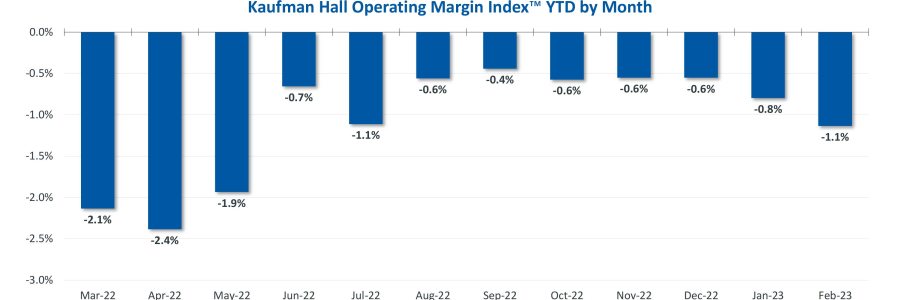
What You Should Know:
– Hospital finances are beginning to stabilize as razor-thin margins become the new normal, according to the newest data from Kaufman Hall. The National Hospital Flash Report draws on data from more than 900 hospitals from Syntellis Performance Solutions.
– The latest National Hospital Flash Report shows that the high level of variance that plagued hospital margins over the past three years is beginning to subside as external economic factors like labor shortages, higher material expenses, and a patient population that is increasingly seeking care outside of the hospital affect hospital finances.
Key findings include:
Median YTD Operating Margin Remains Negative
The median year-to-date operating margin index for hospitals was -1.1% in February, down slightly compared to -0.8% in January. Despite the slight dip in financial performance, February marked the eighth month in which the variation in month-to-month margins decreased relative to the last three years.
Non-Labor Costs Drive Hospital Expenses
Hospitals continued to incur high expenses that negatively affect margins. Kaufman Hall experts point out that February represented a shift from labor to goods and services as the primary driver of hospital expenses. Inflationary pressures led to significant cost increases in goods and services, increasing non-labor expenses by 6% year-over-year. While hospitals still face labor shortages, labor expenses appeared to hold steady, indicating less dependence on contract labor.
Ongoing Shift in Patient Care Setting
The onset of the COVID-19 pandemic kickstarted a shift in patient behavior that continues today. Patients continued to seek more of their care away from inpatient settings, with February 2023 outpatient revenue up 14% compared to February 2022. Due to the shorter month, discharges, patient days, and ED visits were all down slightly in February compared to January. On a per-day basis, however, the average length of stay in hospitals was down, while ambulatory surgery centers and outpatient operating room minutes saw volume increases last month.
